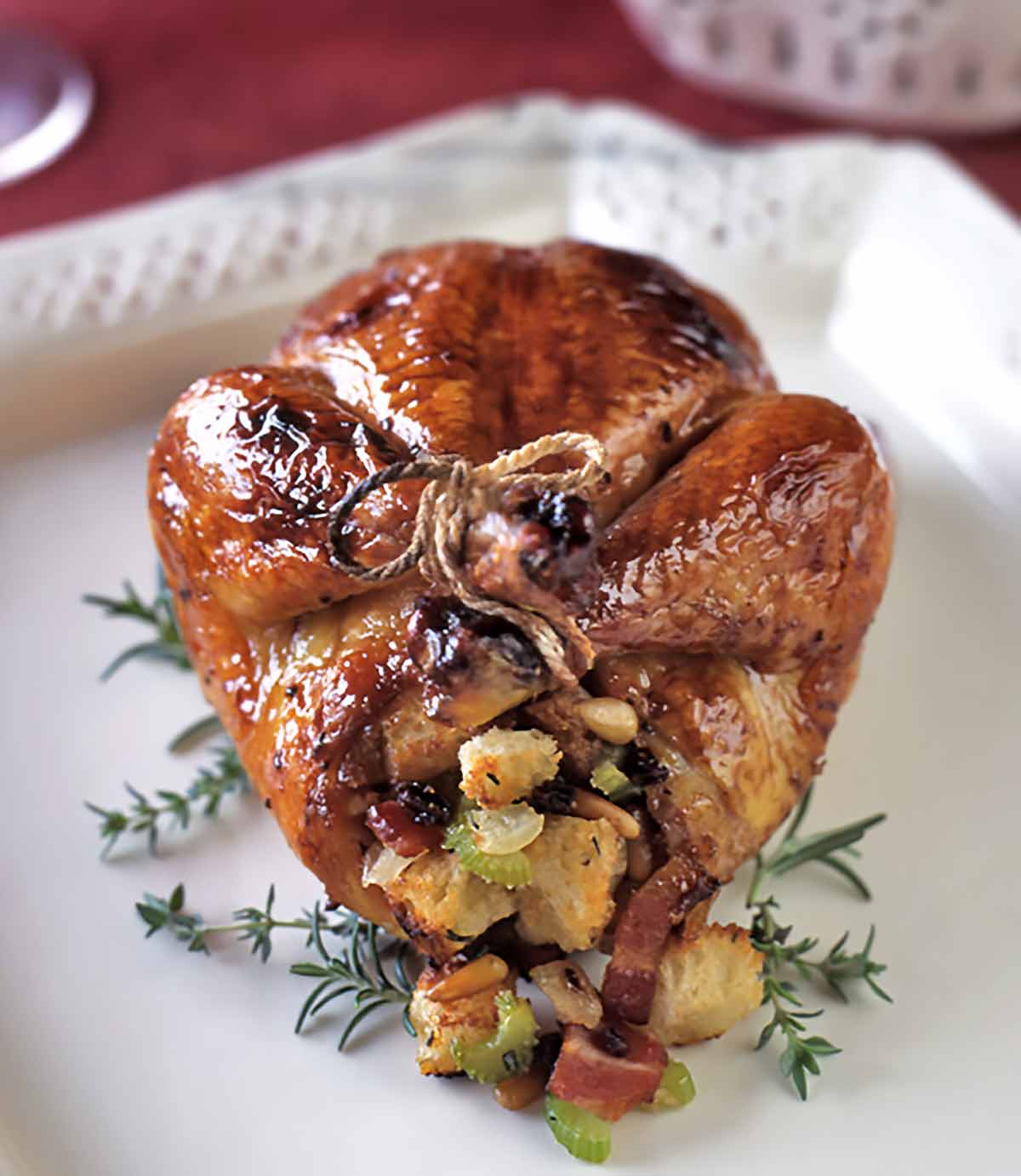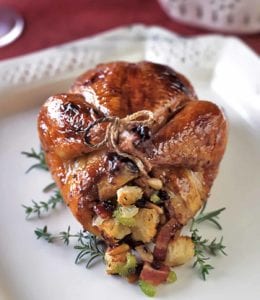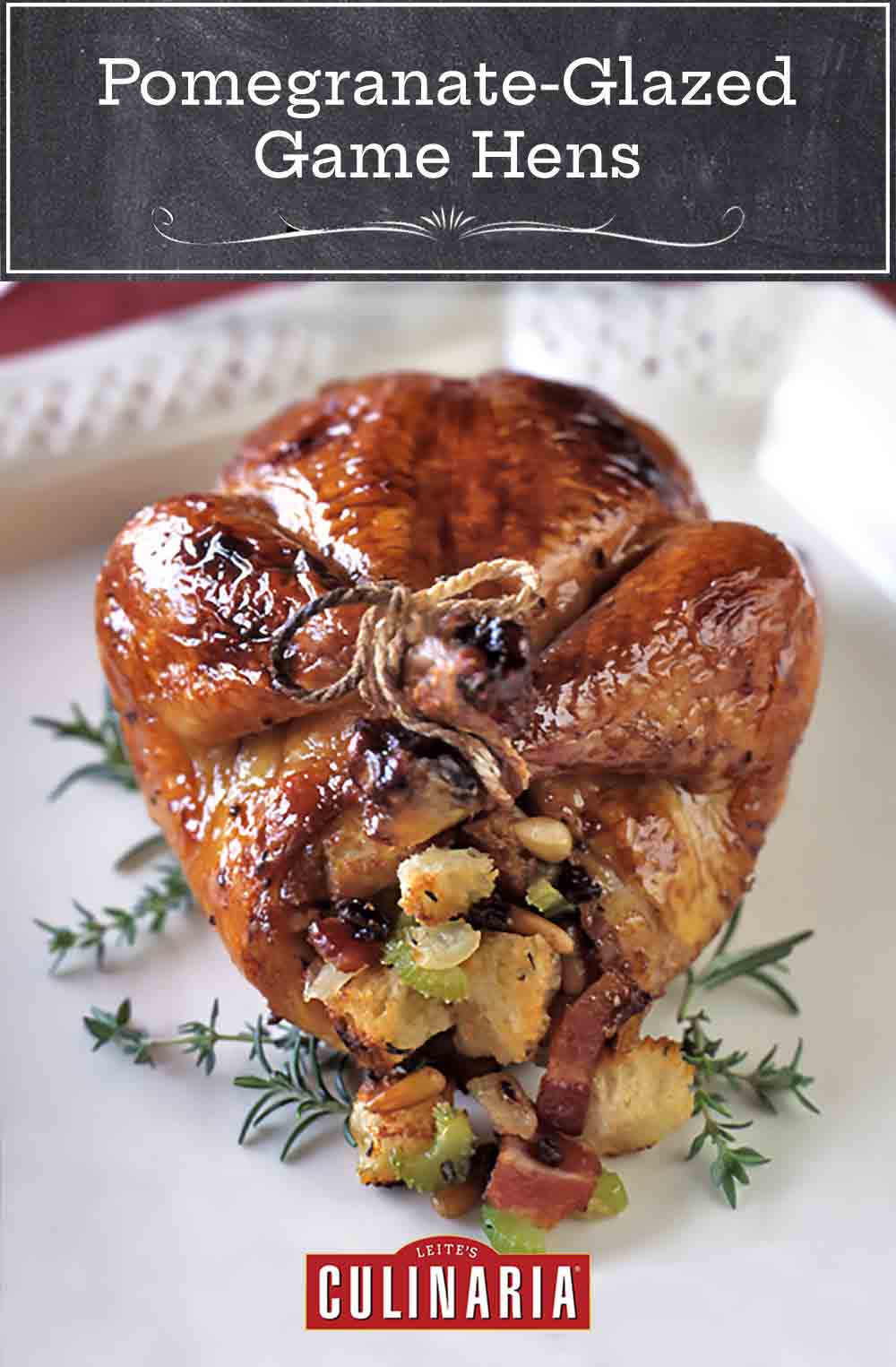

Pomegranate-Glazed Cornish Game Hens with Pine-Nut-and-Currant Bread Stuffing
Ingredients
For the pine nut and currant bread stuffing
- 1/2 loaf store-bought or homemade peasant bread, cut into 1/2-inch (12-mm) cubes (about 6 cups)
- 2 tablespoons (1 oz) unsalted butter
- 1 small onion, finely chopped
- 2 stalks celery, thinly sliced
- Salt
- Freshly ground black pepper
- 1/2 cup pine nuts, toasted in a dry skillet
- 1/2 cup currants
- 1 tablespoon chopped thyme leaves
- 1 tablespoon chopped sage leaves
- 2 teaspoons chopped rosemary leaves
- 2 slices thick bacon, cut into 1/8-inch pieces
- 1 1/2 cups chilled canned or homemade chicken stock
For the Cornish game hens
- 2 cups pomegranate juice, (POM & R.W. Knudsen, preferred)
- 1/4 cup granulated sugar
- 3/4 teaspoon whole black peppercorns, cracked
- Four (22-ounce) fresh or thawed Rock Cornish game hens
- Salt
- Pine Nut and Currant Bread Stuffing
- 1 to 2 cups chicken stock
Instructions
Make the pine nut and currant bread stuffing
- Preheat the oven to 400°F (200°C).
- Spread the bread in a single layer on a rimmed baking sheet. Toast in the oven until crisp and golden on the edges, 10 to 12 minutes. Let cool.
- In a large skillet over medium-high heat, warm the butter until it melts and begins to brown. Add the onion and celery and saute, stirring occasionally, until tender, translucent, and starting to brown, about 4 to 5 minutes.
- Season with salt and pepper. Scrape the mixture into a large bowl and stir in the pine nuts, currants, and chopped herbs.
- In the same skillet over medium heat, cook the bacon until golden but still chewy about 8 minutes, depending on the thickness. Tip the bacon and pan drippings into the vegetable mixture. Let cool.
- Add the bread to the vegetable mixture along with the chicken stock. Let the bread absorb the stock and mix thoroughly. Season to taste with salt and pepper. (You can cover and refrigerate the mixture for up to a couple days.)
Prepare the Cornish game hens
- In a small saucepan, bring the pomegranate juice, sugar, and black pepper to a rolling boil. Reduce to about 3/4 cup, about 20 minutes, depending on the size of your pan.
- Pour the glaze into a heatproof measuring cup and let it cool. (You can cover and refrigerate the glaze for up to 1 week.)
- Preheat the oven to 450°F (230°C). Adjust the oven rack to the middle of the oven.
- Pat the game hens dry with paper towels. Snip off the tails and remove any excess fat around the body cavity and neck.
- Salt the cavities of the game hens and fill each with 1/2 cup of the stuffing. Tie the legs together with kitchen twine and tuck the wing tips underneath.
- Season the outside of game hens well with salt. (The glaze contains plenty of pepper, so no additional pepper is needed.) Place the hens on a rack in a large roasting pan or on a rimmed baking sheet, making sure they're not touching. Roast for 20 minutes.
- Reduce the temperature to 400°F (200°C) and add enough chicken stock to the pan to cover the bottom by about 1/2 inch. Brush the game hens well with the glaze.
- Continue to roast the hens for 45 minutes, brushing with the glaze every 15 minutes. Five minutes before removing the birds from the oven, give a final brush of glaze.
- Transfer the game hens to a platter and remove the twine. Loosely cover with foil and let them rest for 10 minutes.
- Meanwhile, strain the pan juices into a small saucepan and reduce over high heat to concentrate the flavor. For a sweeter taste, add a tablespoon or two of the pomegranate glaze before reducing. Season the pan sauce with salt and pepper to taste, if necessary.
- Pass the pan juices on the side with the game hens.
Notes
Explore More with AI
Nutrition
Nutrition information is automatically calculated, so should only be used as an approximation.
Recipe Testers’ Reviews
This recipe combines a few of my favorite winter ingredients—I had a bowlful of pomegranates that I had used for the juice and I picked up 4 Cornish hens from my local butcher. This particular stuffing was an excellent addition. I enjoyed the addition of pine nuts and currants, which aren’t ingredients I’ve used in stuffing before. I had a homemade boule left from the weekend and I used it in place of the peasant loaf. I did have more stuffing than I could fit into the birds and I cooked it in the recommended manner. I actually preferred it this way with more crisped bits. The Cornish hens themselves were juicy and had a delicious flavor from the pomegranate glaze. The roasting time was accurate—after an hour, they were crisp and the juice was nice and clear.
All in all, the recipe was very successful. I served them with a green salad, roasted Brussels sprouts, and creamy polenta.
Everything about this recipe is a winner. It’s perfect from the glaze to the stuffing. I love the slight sweetness of the stuffing that’s imparted by the glaze and the currants, and the hens come out perfectly moist with a sweet, peppery, crunchy skin. Wonderful! There is a lot of extra stuffing. I served this simply with green beans.












This was our Christmas eve dinner. Was delicious, we loved the color, flavor and juicyness of these hens. I did swap basmati rice for the bread in the dressing and it was fantastic. Definitely will be on our table again.
Wonderful, Bbqgoddess. We’re so pleased that you loved it.
Made these for our family Thanksgiving dinner last night. Cornish hens make a lot of appearances at our table so I like to change them up each time. This variation was extremely welcome. Our hens were juicy and flavourful and looked beautiful on the plate! The stuffing was also a hit. I share the opinion that the switch in the bread, the dried fruit, the nuts and herbs are what create the differences between stuffings. The pine nuts and currants were a different and welcomed change. Thank you for this fabulous recipe!
You’re welcome, Ilda. That looks gorgeous! Happy Thanksgiving!